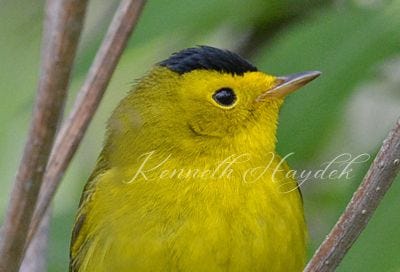May: Wilson’s Warblers
Wilson’s warblers, and likewise Wilson’s plovers and Wilson’s snipes, owe their names to the American ornithologist Alexander Wilson who first described them. In 1811, Wilson called this particular warbler a “green black-capt flycatcher.”
Birders use the saying “Wilson wears a hat” to remember this bird. Whether you liken its crown feathers to a hat or a hairpiece, the black feathers atop the head of a male Wilson’s warbler make it easy to identify. Adult males are known for their solid sleek black crown, while adult females have either olive crowns or a delicate, variable appearance of black feathers on their heads. Juvenile birds have olive crowns.
As for the color of their body plumage, that varies slightly depending on subspecies. There are six genetically distinct subspecies of Wilson’s warblers, each with their own range across North America. Birds in the west are a brighter, more golden yellow, while birds out east tend to be paler yellow with a heavy mix of olive feathers.
Being around four inches tall, these warblers are among the smallest warblers, with long thin tails, large heads, round bodies, and thin bills. Unlike many warblers who flit among the treetops, Wilson’s warblers forage for insects—their main diet—in forest understory or on the ground. They may get their food by hovering to snatch insects out of the air or by picking them off foliage, including the underside of fallen leaves.
Around 54% of North American Wilson’s warblers breed in the Boreal Forest, from Alaska to eastern Canada, living in shrubby thickets often near water, particularly gravitating to areas with willows, alders, and aspen stands. In the winter, these birds can be in found Mexico, Central America, and northern Caribbean islands, in environments as diverse as coffee plantations, lowland brushy woods, and high-elevation tropical plains. While migrating, they may layover in coastal or desert scrubby areas, thinly wooded suburban areas, and shrubby areas near streams.
Most Wilson’s warblers build their nests on the ground, except for Pacific coast birds, who build their nests several feet off the ground. Females use depressions at the base of saplings, plant stems, or logs to build their nests, using leaves or sedges as a base and then using mosses, grasses, and hairs to make a secondary layer.
Wilson’s warblers are seasonally monogamous, with males sometimes mating with more than one female. They have one clutch each breeding with two to seven eggs; Pacific birds lay fewer eggs but tend to try more than one clutch. Parasitism by brown-headed cowbirds is a threat, especially in the west.
Whereas the role of singing in the case of most warblers is primarily the male’s domain, with Wilson’s warblers, occasionally the female joins in too. Males sing their cheery song frequently throughout spring migration until they are settled and nesting.
Breeding migration is March through May, and winter migration is August through October. While migrating, these birds pass through the entire continental 48 states, so everyone might have a chance to see one. But because these birds are insectivorous, and not feeder birds, you will likely have to go out to wooded areas to find them. So, bring a pair of binoculars and your sense of adventure—these hyperactive little birds like to move!
Sources:
https://www.allaboutbirds.org/guide/Wilsons_Warbler/
https://www.audubon.org/field-guide/bird/wilsons-warbler
https://ebird.org/species/wlswar
https://www.birdscaribbean.org/tag/wilsons-warbler/
https://www.borealbirds.org/bird/wilsons-warbler
https://abcbirds.org/bird/wilsons-warbler/
https://www.birdsandblooms.com/birding/bird-species/wilsons-warbler/
https://www.birdgenoscape.org/wilsons-warbler/



